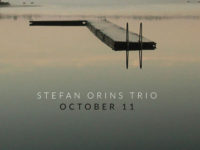In a career spanning decades, composer-pianist Yves Leveille has established himself as a key figure on the Quebec jazz scene.
Drawing from contemporary and traditional jazz, classical, and world music, Leveille’s distinctive musical aesthetic is noteworthy for its refined approach to melody and harmony. He won the Opus Awards two years in a row for best jazz concert and album, and his last LP, Phare was also nominated for Opus Awards’ jazz album of the year.
For L’echelle Du Temps, Leveille recruited virtuoso musicians on their respective instruments, each with an uncommon capacity for expression and sensitivity: Lizann Gervaison on first violin, Olivier Thouin on second violin, François Vallières on viola, Émilie Girard-Charest on cello and Étienne Lafrance on double bass.
I asked, “why this music, why now, and how did the tracks form to fruition?”
Yves Leveille told me, “I had wanted to make a piano and strings album in the spirit of chamber music for quite some time. When I was studying music in Quebec City – specializing in composition – I wrote works for different nomenclatures, including the string quartet. I then turned to creative jazz, so I left this approach aside to write for jazz ensembles and play my music. Four years ago, I was commissioned to arrange [French singer Marie-Therese Fortin chante] Barbara’s songs for a string orchestra [called Les Violons du Roy]. I also wrote a work for oboe, piano, and strings for this ensemble.
“This gave me the desire to do something more personal that reflects where I am in my approach as a pianist and composer evolving in contemporary jazz. I wanted this album to be uncompromising, true to my varied tastes, ranging from modern jazz and classical music to chanson and world music. L’Echelle du Temps represents the importance of the present moment, as the hourglass is inexorably running out.”
The title track opens L’Echelle du Temps with a string introduction to gentle harmonies from Yves Leveille’s piano. A deep, sonorous string melody oozes into the music with pizzicato accompaniment across the top, creating deeply textured waves which flow beautifully. The right-hand piano solo rises over the harmonies and lifts and soars over the strings. The strings respond with harmonized chords until the ensemble comes together under the piano to uphold, lift and deliver music which is breathtaking in its delivery. A change of tone sees the strings energized, adding emphasis to the music before the piano tones it down again with gentle melodies. Violin calls, and cello responds in emphatic response. The final section of “L’Echelle du Temps” is centered on the violins’ melody before a chordal section finishes with a sigh.
“Couleur Grenade” is a well-worked number that creates different atmospheres and musical landscapes, as the strings lead in a tremulous manner with the deep voice of the cello and bowed bass sumptuously phrasing in reply. The piano enters with a thematic solo, with changes in tempo and time before the deep voice of the plucked bass notes underpin the harmonies. Strings then once again re-take the lead with some gorgeous glissando and delicate folky traces. The soar of the violin is interrupted by a change of emphasis and pace, and “Couleur Grenade” closes with strings returning to the opening theme in glorious harmony – with a twist.
“Missive” opens with a piano solo into which the bass inserts its voice before emerging from the background to solo itself. The two instruments duet, with the piano leading before the rest of the strings, enter in sweeping style, creating harmonic contrast with the theme. “Encodage” opens with a lively, uplifting statement of intent – which then develops into a jazz polka-dot to and fro with rhythmic changes, solos and interludes that grasp the attention and keep the crazy rhythms alive. Fast fingers, contrasting full-throttle bowed lines, and polyphonics add interest and keep the listener enthralled across this song. At times, the strings intertwine and merge to blend and create lines that come together and, just as quickly, find their individuality again. Wonderful arranging and great to hear. The final section has a fast walking gait, and the track finishes with a wonderful descent.
“Sans Retour” is an altogether gentler affair, almost melancholic in its opening as three-note phrases loop gently around the chord line from the piano. The strings enter in gentle harmony, caressing and enhancing the theme, wrapping around the lines like a musical blanket. Each has a voice to add, but is also in harmony with the ensemble. Halfway through, a violin rises and sings across the top, before dipping back down to rejoin harmonic lines which are beautiful and warm. The cello sighs and rises to solo, with bass providing support before the ensemble again unite to complete this luxuriantly ornamented number. “Une Journee Comme Ca” is playful and extravagant in its arrangements, with strings creating contrasts to piano lines which weave their way deftly among the plucked, bowed, and scraped sounds of the strings. The final section is dramatic and packed with textured lines.
“Embrasure” is thematic, dramatic and poignant at times, with grandiose piano giving way to gentle harmonies from the strings and touches of almost orchestral flavors. The bass line is intriguing and topped out by low harmonies, which add deep, guttural texture to sections of the piece. This is a piece of tone and contrast, like a poem with each section creating different musical pictures, yet all is part of the whole because of the subtly linked harmonies. The next section contains a wonderfully intricate sighing created by the violin. The open lines of the supporting piano, the echoed response of the strings, and the drifting together of the ensemble to create a harmonized section are divine, as is the gentle release of the ending.
“Le Reservoir” closes L’echelle Du Temps, and is a lesson in harmonic exploration, with multilayered harmonics, solo sections, and dynamic rises and falls. In just over seven and a half minutes, you experience many different feelings and emotions due to the well-worked structure of the piece.
Yves Leveille said he wanted high-caliber musicians and got them for this recording.
“Most of the pieces took shape as I was writing according to the inspiration of the moment, one piece leading to the other in a way,” Leveille told me. “Some of them had been written some years ago but had not been recorded, so I arranged the music for strings and piano by modifying and improving the pieces according to the musical context. The choice of string players was of primary importance for the recording. I needed high-caliber musicians for a flawless rendition: The musicians were fantastic with all the necessary sensitivity to play on this project.”
At times, while harmonies are happening, a player is creating their own line in the background and delivering thoughtful additions to the music. Every piece contains changes, feels like an exploration, and travels along a slightly different path. Yet, there is a harmony, not just in the music but in how the musicians relate to each other, their entries and pauses.
Together, they show that there is more to great music than simply good composition: It has to be interpreted by musicians who understand it. On this recording, you sense they really do.
Third stream music, which I would say this is, contains some of the most beautiful coming together of classical and jazz traditions and arrangements. The music feels personal, full of character, unfettered, and wonderful in the true sense of the word.
‘L’Echelle du Temps’ will be released worldwide Friday, April 8th, on Effendi Records.
- Wabi Sabi – ‘The Love Insane’ (2024) - March 24, 2024
- James McGowan Ensemble – ‘Reaching In’ (2023) - December 10, 2023
- Defne Sahin – ‘Hope’ (2023) - November 19, 2023




